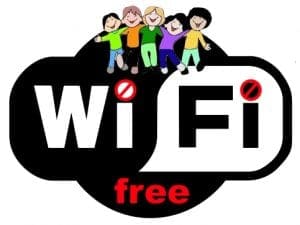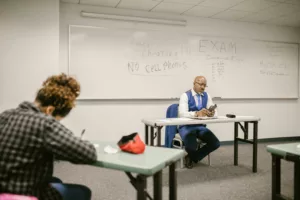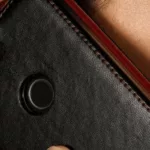Today the majority of schools are WiFi-connected. And although this really helps the students with their studies, experts are concerned that WiFi in schools may be causing children to develop EMF-induced health problems—like anxiety, sleep disorders, and even chronic diseases like cancer.
Not that long ago, most schools used chalkboards as a means for students to learn. Now, it’s common to see them using tablets and other devices as learning tools. Although this seems beneficial to the learning environment, it may do more harm than good. Have a look.
Table of Contents
ToggleHow Is WiFi In Schools Affecting Children?
The use of electronic devices in schools as educational tools can become a source of distraction for the students. They can access so many apps and games that it takes away from their learning time. It’s hard enough already to regulate how much time a child spends online.

This is a huge problem. Some experts are even calling for a complete smartphone ban in schools.
Besides that, EMF sources like WiFi emit radio frequencyRadio Frequency (or RF), a subset of EMF, encompasses electromagnetic wave frequencies ranging from about 3 kilohertz (kHz) to 300 gigahertz (GHz). These frequencies are extensively used in modern wireless... More radiation"Radiation" in the context of Electromagnetic Fields (EMF) refers to the process by which energy is emitted and transmitted through space or a material medium in the form of electromagnetic... More to connect with the devices and the network source. And years of research have revealed that prolonged exposure to these kinds of EMFs can cause one to develop many health problems ranging from minor sleep disorders to chronic diseases like cancer.

Want to Slash Your EMF Health Risks?
Good! Learn the one small change you should make right now.
Learn more in my “EMF Health Effects” post collection.
Thanks to the marvelous achievements in the technological world, we’re now surrounded by EMF everywhere we go. And the last thing we’d want is to add more EMF sources in places where our kids spend the most time.
What Can Be Done To Reverse The Effects?
Science is clear. Adding WiFi to schools isn’t a good idea, especially when kids are on the receiving end with developing bodies and inadequate EMF resilience.
The most logical thing to do right now is to lessen the amount of WiFi in schools and restrict or ban mobile devices.

And people are taking action.
Nations Taking a Step Forward and Banning WiFi in Schools
Some nations have already taken the necessary measures to ban and restrict school WiFi usage. These countries include France, Belgium, Spain, Israel, Australia, Italy, Switzerland, and Germany. These countries recognize the harmful effects WiFi in schools can have on children and have taken action.
Even in the United States, some school districts have begun removing WiFi from their schools.
In 2017, the Maryland State Children’s Environmental Health And Protection Advisory Council were the first to recommend that their schools use only wired internet and reduce EMF in classrooms.
And in February 2018, The Santa Fe Waldorf in New Mexico removed WiFi in their elementary school building and has been fully WiFi free since.
Here are some more examples of people taking strict actions to protect children from EMF exposure in schools.
Collingwood, Ontario
A private school in Collingwood, Ontario, completely removed WiFi and installed hardwired technology. Dr. Magda Havas from the Trent School of the Environment said this is excellent news, and she wishes other schools would follow their lead.
Adding to this, she said:
“I understand that the teachers in the school are grateful, as are the parents, that their children are NOT going to be exposed to microwave radiationMicrowave radiation is a form of electromagnetic radiation with wavelengths ranging from one meter to one millimeter; with frequencies between 300 MHz (0.3 GHz) and 300 GHz. This type of... More, a possible carcinogen.”
Surrey, British Colombia
A school in Surrey, BC, also removed WIFI, saying, “although there is far from universal agreement as to the dangers of wireless technology, and there are many with vested interests in its continued use, evidence of its harmful effects is extensive and widespread. The default position must, therefore, be on the side of safety.”
France
In 2015, France passed a national law banning WiFi in nursery schools as well as many new laws to protect the general population from EMF’s biological effects. They:
- Banned WiFi in Nursery Schools.
- Established a National Radiofrequency Agency
- Made companies publish SAR information about their cell phones and inform consumers on ways to lower EMF exposure from the phones
- Recommended elementary schools to turn off WiFi routers, except when required
- Made cell phone companies add a section in their advertisements saying that consumers must hold their phones away from their heads
- Started working on a government report to better understand and explain electromagnetic hypersensitivity
Russia
Following the same footsteps, Russia set new health and safety regulations and banned WiFi and smartphones for distance learning. The new rules for digital school and computer learning at home contain the following:
- A ban on WiFi and wireless internet connections for primary school.
- A ban on smartphones for purposes of education.
- A recommendation to use books for home study, not computers.
- Advice against locating mobile network base stations (cell towers) on school grounds.
Hamburg, Germany Removing WiFi from Six Schools
On November 29, 2014, an article appeared in the Flensburg Tageblatt, a reputed German news organization, about Hamburg, Germany, removing WiFi from six schools due to a new ban stemming from health concerns of EMF radiation.

Since the article is in German, a customer requested that we translate it, so here’s the translation below.
Also, note that we’ve lightly paraphrased and divided this article into sections, so it’s easier for you to read.
From The Editors of The Flensburg Tageblatt
Six schools in Hamburg, Germany, are planning to find their way into the digital age. But city school officials are now backing off as they investigate if the wireless network WLAN is too dangerous for students’ health.
The Investigation
The school authorities announced that, after the summer holidays, they’ll equip three district schools and three high schools with tablets and notebooks.
They put this plan on ice for the time being because these gadgets use wireless internet access through wireless network WLAN. And the potential health effects and the legal framework aren’t clear.
“Six schools are replacing chalkboards, textbooks, notebooks, and pencils with laptops and tablets in class,” said school senator Ties Rabe. And during the two-year project, up to 1,300 students (about 30 percent of children) were supposed to participate.
Now the school authorities are “backing off,” saying, “We are currently investigating whether there are data privacy protection or other legal problems.”
The project made big waves because of the non-party representative Walter Scheuerl who is trying to bring down the project, with two requests from local citizens and various reports stating that data transmission over wireless networks happens through extremely high microwave frequencies.
WiFi in School is a Bad Idea, Say Doctors
Some doctors recently criticized the introduction of tablets, smartphones, and WLAN as “an uncritical acceptance of progress hype.”
In an open letter, 20 doctors from “Doctors Working Group Digital Media in Stuttgart” said that the school authorities are ignoring the concerns coming from science and medicine regarding wireless technologies.
“The correlation of the increase of overwork, headaches, ADHD, and mental illness with the growing use of digital media is worrying,” said psychiatrist and brain researcher Prof. Manfred Spitzer.
According to the latest state of science, the negative health effects are clear. The amount of radiation could lead to impaired concentration, in addition to sperm damage, DNA strand breaks, and thus cancer.
Manufacturers, as well as the Federal Office for Radiation Protection, are already warning not to use wireless devices close to the body. Neither the Hanseatic city’s school board nor health authority could respond to such warnings.
“It’s Not Harmful” — Dirk Petersen
Dirk Petersen, an environmental expert at the Hamburg consumer advice center, relativized: “In our view, there is no reliable information that it is harmful.”
The radiation level was simply too small, said the expert.
However, Ellen Kruse, a spokeswoman for the AG Electrosmog of the BUND Hamburg, criticized saying, “There are a lot of neutral studies showing that WiFi is very harmful.” She called for independent experts to educate schools.
The World Health Organization warns that the use of wireless networks could possibly be carcinogenic. “We are for a precautionary approach,” said Kruse. However, the BUND is not anti-progress and advocates for wired internet access in schools.
In his requests to the Senate, Scheuerl also addressed the subject of data protection declarations and whether the legal guardian, adult students, and teachers have a way of accepting them and what would happen if they would not sign them.
The school board admitted they are now investigating this. Scheuerl said: “The authorities had not carefully prepared for this beforehand.” However, the use of WLAN is from his point of view, ok if they would agree to it. “The use of the schools for the Internet research is important, but it is also about information literacy,” said Scheuerl.
He also called for a general education about pedagogic and psychological consequences, liability risks, copyright issues, and risks.
What Is The Future For WiFi In Schools?
Although some authorities are taking action, unfortunately, at this rate, it doesn’t appear that WiFi in schools will be going anywhere anytime soon. Even with all the scientific studies showing how harmful these signals can be for human health (especially children), WiFi use is expanding.
The EMF radiation on which WiFi depends–from sources including routers, mobile phones, and baby monitors—is orders of magnitude stronger than the natural amount of radiation life on earth evolved alongside for millions of years.
WiFi is essentially a huge health experiment, given that it’s new and we don’t really know how this will affect human health in the long term.
We can only speculate on how something like this will unfold. The massive amounts of exposure have only recently become a big problem, and negative health effects such as cancers can take decades to develop and manifest. And on top of that, there aren’t many research studies on the effects of WiFi radiation.

Children are so vulnerable to WiFi because their nervous systems are still developing. They have thinner skulls, so their brains absorb more of the radiation, increasing the risk of cancer and brain tumors.
This is why WiFi in schools is such a concern. They have many decades of exposure ahead of them.
The good news is that, as time goes on, more and more schools and districts are beginning to realize the harmful effects WiFi in schools can have on children and teens.
Protecting Our Future: Best Practices for Schools
The best practice to keep our children safe is to take the appropriate measures to reduce exposure.
The Environmental Health Trust (EHT) recommends a number of best practices that schools worldwide can adopt. They’re as follows:
- A corded phone should be available in every classroom and dorm
- Devices should be kept in airplane mode, with all antennas off (including BluetoothFrom the perspective of someone concerned about the health effects of electromagnetic radiation, understanding Bluetooth radiation is crucial, especially in our increasingly wireless world. Bluetooth technology, ubiquitous in our daily... More, cell service, and WiFi)
- Laptops and computers should be connected via an ethernet cable instead of wireless internet
- Computer peripherals should be wired (no wireless mice, keyboards, headsets, etc.)
- Schools should implement a cell phone off policy, applicable in classrooms, hallways, and playgrounds
- There should be no cell towers mounted on or near school property
- Tablets can be used in airplane mode with pre-downloaded programs and ethernet-only connections
- All fixed classroom devices such as printers, projectors, and electronic whiteboards should be hardwired
- There should be ethernet plugs available in all rooms
Digital Safety Education
Besides the recommendations above, the EHT also recommends community education as an important step in keeping children safe and healthy in this tech-driven world.
This would include things like regular digital safety education as part of the curriculum and posters on how to reduce the radiation hung on classroom walls.
Adhering to the above guidelines means that devices in schools can still be used for learning—they should simply be used in the safest way possible. This would allow schools to remain innovative and up-to-date on technology without putting the health of their students at increased risk.
Putting these practices into use is what will help us minimize children’s risk of developing cancer and other health conditions, even at a young age. The amount of WiFi they are exposed to in school can be avoided or significantly reduced without compromising the quality of their education.
Final Thoughts
Protecting children from EMF’s health effects is important, but so is not letting them be left behind the curve.
EMF’s biological effects aren’t the only risk of modern technology. Experts say that prolonged tech use can affect an individual physically, mentally, psychologically, and emotionally.
So, what can you do?
Here’s a simple answer—build a healthier relationship with technology. This way, you can enjoy the full benefits technology brings without being subjected to the health risks that tag along.
And how do you do that?The Healthier Tech Podcast from SYB features experts from different industries sharing how to live safer, healthier lives alongside technology. We’re available on all major platforms. So, give it a listen.







